If the softness of the food is all that is at issue, might we suggest this incredibly creamy and satisfying recipe for beef chili with pancetta, ancho, and chocolate? In fact, if that’s the case, you might even want to try adding an unexpected ingredient — oatmeal — to your chili because although oatmeal won’t change the chili’s softness, it will add a surprising hit of texture and may even keep you full for longer. Finally, feel free to top your chili with other soft foods, including guacamole, sour cream, shredded cheese, and thin slices of green onion, and to accompany it with some nice, soft cornbread or rice.
25 Soft Food Ideas That Will Leave You Feeling Full And Satisfied
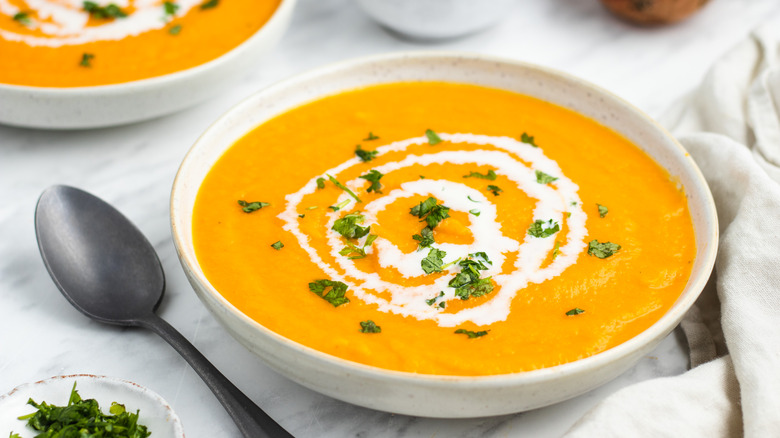
Crispy, crunchy, and chewy. All are words associated with toothsome eating experiences. So are dense, textured, crusty, crackling, and we could go on, but we won’t for now because, at the moment, we’re finding ourselves more fascinated by the possibilities that may be offered by “soft foods.” Although the phrase “soft foods” tends to bring to mind bland, boring foods that are more about sustenance than actual enjoyment, we know for a fact that’s not the whole story.
Certainly, there are situations that call for only the most mildly flavored and textured soft foods. Your health care professional might, for example, decide that a soft food diet is appropriate after general anesthesia (per the Cleveland Clinic), which temporarily causes the digestive tract to cease its normal activity, therefore requiring a gentle transition back to regular eating habits. And when babies are learning to eat? Doctors, of course, recommend only soft, bland foods such as bananas and cream of rice.
However, there are plenty of other circumstances that call for a soft food diet in which only the literal softness of the food is at issue. For instance, Healthline points out that after dental surgery, you may need to stick with soft food for a while, but that soft food needn’t be bland; it can be flavorful or even highly textured. And that’s quite fortunate because we’re about to present to you 25 soft food ideas that are so filling and satisfying that the fact that they are, indeed, “soft foods,” seems almost beside the point.
Eggs (in Every Way)
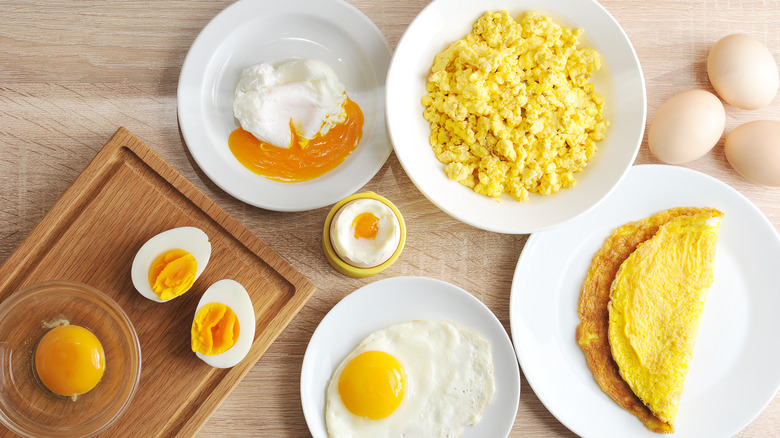
Eggs are known by many a nutrition expert as the “perfect protein.” This is because, as registered dietitian Mackenzie McCune shared with the Shore Medical Center, a single large egg delivers around 6 grams of high-quality animal protein and 13 essential vitamins and minerals. And all of that at the caloric cost of a mere 70 calories.
Although, every so often, some new clinical study attempts to challenge the egg’s right to wear its arguably well-deserved health halo, the nutritional benefits of eggs continue to stand up to scientific scrutiny. As recently as February of 2022, researchers from the University of Arkansas were advocating in the academic journal Nutritional Reviews for public-health efforts to be made toward supplying more eggs to people who may be dealing with food insecurity. The reason? Because eggs are so nutritionally “efficient.”
Since there is virtually no way to prepare an egg that does not fall within the category of “soft food,” eggs make soft-food eating easier than you might ever imagine. They can be scrambled, fried, poached, boiled, steamed, or turned into an omelet (with soft fillings such as cheese, jam, or spinach). But they’re also a great add-on for many other soft foods discussed below, including polenta, creamy grits, and mashed potatoes.
Shepherd’s Pie
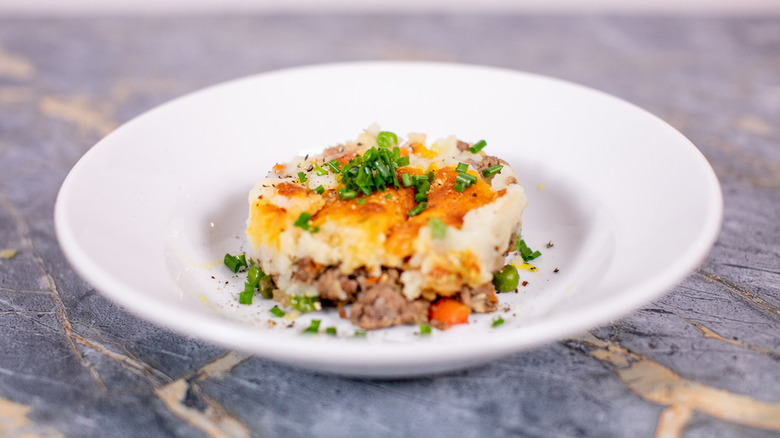
As said, it’s arguable that eggs are one of the most “efficient” forms of protein, both in terms of cost and calories. Similarly, it’s reasonable to argue that shepherd’s pie — a classic British pub food and family-dinner favorite — is one of the most efficient ways to consume a nutritious savory meal in the event that you are temporarily restricted to soft foods but are still able to tolerate small pieces of soft-cooked vegetables, as Healthline explains many on soft food diets are.
One of shepherd’s pie’s most oft-repeated origin stories is that it was dreamed up in 18th-century Britain and/or Ireland as a way of using up leftovers, per Sustainable Dish. It actually makes sense when you consider that shepherd’s pie is made of ground meat (traditionally lamb, but beef is fairly common, too) that’s been sautéed with onions, peas, and carrots until all of it is soft, moist, and easy to chew and swallow — and then topped with a soft, salty, and creamy crust of mashed potatoes.
What is not to love about this filling and satisfying soft food alternative? Here is a recipe for braised lamb shepherd’s pie, to get you started. And if you love the idea of a stew made with meat and well-cooked veggies, but maybe not so much the mashed potato crust, then you can also consider a slow-cooked stew as a filling and satisfying soft food choice.
Matar Paneer
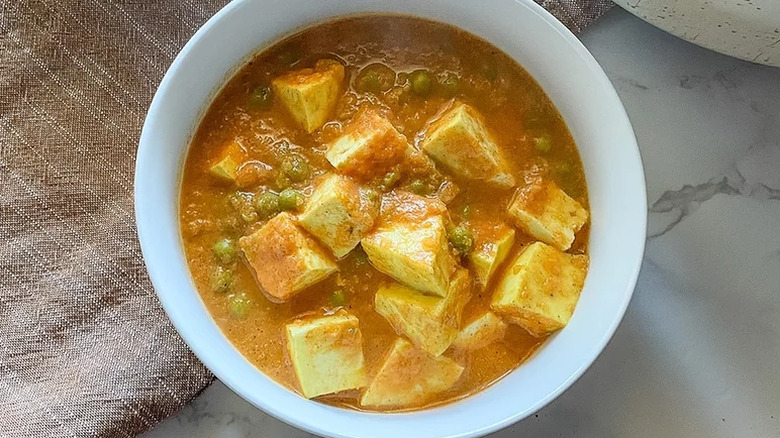
If you’re about to have dental surgery, or if you are otherwise facing some period in which your ability to chew, but not your ability to swallow or tolerate spice, may be impacted, then the north Indian dish matar paneer can be a super-comforting and uber-satisfying choice for a stick-to-your ribs meal that is anything but bland.
The Indian word “paneer” in the dish’s name refers to the eponymous soft, white, mildly flavored Indian cheese that has sometimes been likened to farmer cheese because it, too, is made from milk curdled with an acid such as lemon juice or vinegar, as recipe site Tastessence explains. The Indian word “matar,” meanwhile, refers to peas, per Swasthi’s Recipes. As the name implies, matar paneer is paneer cheese that has been cooked with peas. The sauce that typically accompanies the paneer and peas is a creamy tomato-based sauce known as tikka masala.
There are other ways to enjoy paneer in Indian cooking as well, including with a spinach-based sauce, and most of them can work in the context of a variety of soft food diets — as long as strong seasoning and capsaicin’s heat are not expected to present issues.
Chili
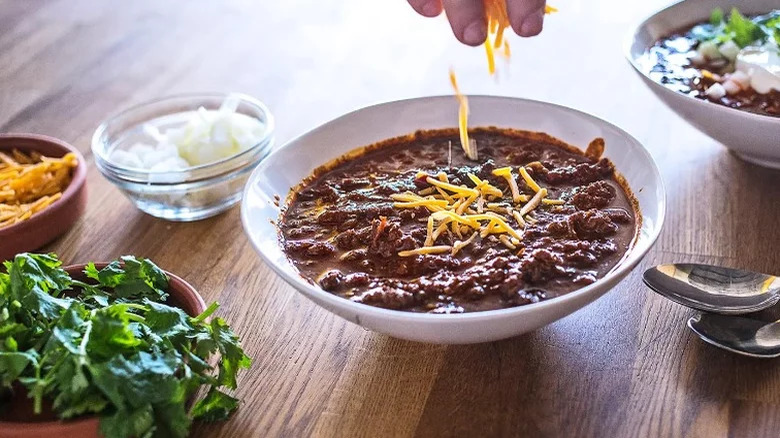
Like matar paneer, chili is a perfect soft food choice for anyone following a soft food diet strictly because their ability to chew is temporarily impaired. Of course, we’re referring only to chili made with shredded or ground meat (or meat alternative) and/or well-cooked beans, as opposed to chunks of meat. The reason is that neither ground meat (or its alternative) nor well-cooked beans require much in the way of chewing. In fact, chili essentially requires no chewing at all. You just have to be able to swallow and to tolerate a variety of seasonings.
If the softness of the food is all that is at issue, might we suggest this incredibly creamy and satisfying recipe for beef chili with pancetta, ancho, and chocolate? In fact, if that’s the case, you might even want to try adding an unexpected ingredient — oatmeal — to your chili because although oatmeal won’t change the chili’s softness, it will add a surprising hit of texture and may even keep you full for longer. Finally, feel free to top your chili with other soft foods, including guacamole, sour cream, shredded cheese, and thin slices of green onion, and to accompany it with some nice, soft cornbread or rice.
Risotto
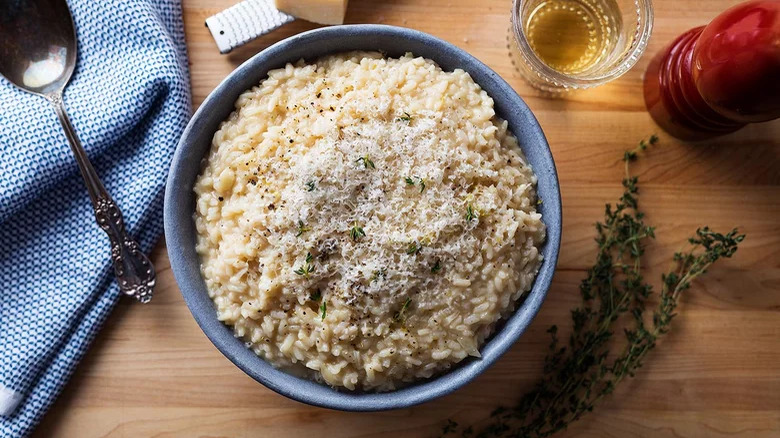
Even on the most restricted of soft food diets, plain white rice is almost always allowed, per WebMD. Risotto is a soft, gooey, starchy rice cooked with a seasoned broth, rather than plain water or even steam. But you know that already if you’ve ever enjoyed a plate of Parmesan risotto, one of the simplest, softest risottos imaginable and one that is both soft and fairly bland.
That being said, virtually all risottos, themselves, are soft. It’s what else you mix into the risotto that will might make it fall outside the realm of “soft foods” (for example, whole shrimp or al dente-cooked broccoli). Most risottos can also be made to be rather bland, but none so easily as Parmesan risotto, which, ultimately, requires little beyond arborio rice, a flavorful broth, a bit of salt (and pepper, if it can be tolerated), and a dusting of grated cheese. And just as easily as you could top your risotto with something that takes your dish away from the “soft” realm, you can also top your risotto with a poached or fried egg for an extra hit of protein.
Cheese Fondue
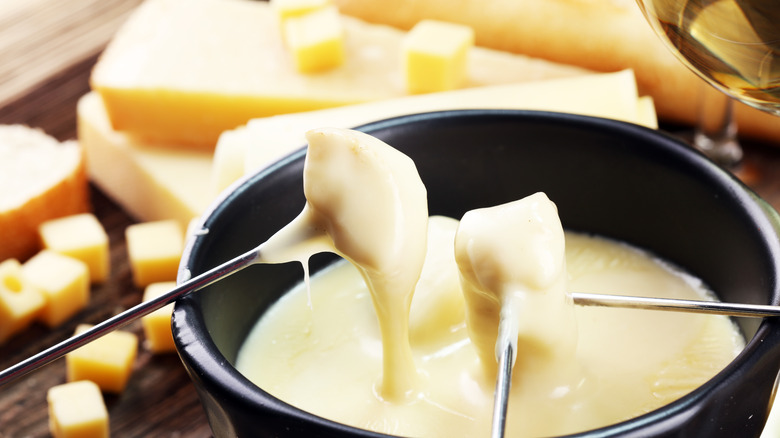
Many cheeses are appropriate on a soft food diet. These include blue cheeses such as gorgonzola and aged and rind-y cheese such as Camembert, both of which are soft enough to eat straight out of the refrigerator. By contrast, hard and semi-hard cheese, including Swiss cheese and raclette, needs a bit of melting if consumed by someone who has just had oral surgery or who’s battling a painful tooth. It just so happens that Swiss and raclette are used frequently in making cheese fondue, which turns hard cheese into a soft foods fantasy, often with the help of a little fortified wine like cognac or brandy.
Fondue, which seems still to be enjoying a heady rise to popularity (beginning at the end of the Victorian age), is believed to date back to ancient times, per BBC Food. In fact, it is quite possible that Homer, who authored the Greek epics the “Iliad” and the “Odyssey,” may have partaken of fondue while recording his stories for posterity. And the cheese that many believe was used in Homer’s fondue? Goat cheese, soft and spreadable cheese that’s often used to top salads, warm vegetable dishes, and enrich some desserts.
For those wondering what soft foods can be dipped into cheese fondue, soft breads, small soft pieces of well-cooked meat, and well-cooked cauliflower seem like excellent options.
Kitchari
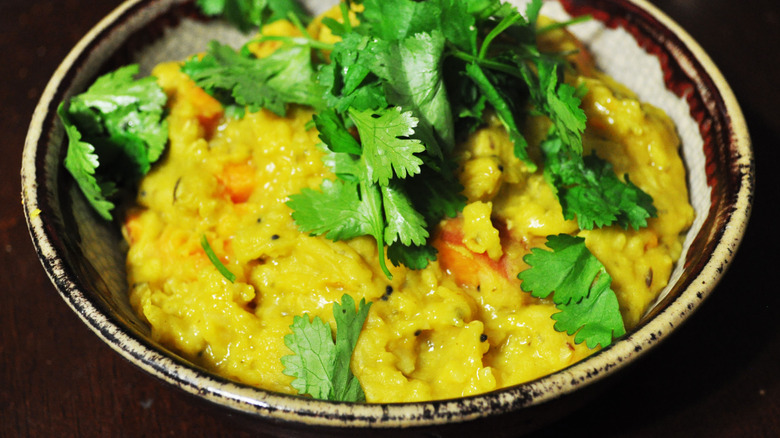
In this compilation of soft foods that are also filling and satisfying, we talk about matar paneer: a northern Indian dish featuring thick slices of mild white cheese smothered in a tomato sauce known as tikka masala and accompanied by perfectly mushy, well-cooked peas. We note that the dish is a great choice for anyone who’s been prescribed a soft food diet for the sole purpose of healing from dental work or other oral surgery — because although matar paneer is wonderfully soft and easy to swallow, it can nevertheless be quite spicy. In other words, it wouldn’t necessarily be appropriate where soft food is prescribed to deal with digestive issues.
For that, there is another classic Indian dish that many in India, in fact, turn to when they need a meal that is easy to enjoy, easy to chew and swallow, and easy to digest. It’s called kitchari, which means “mixture,” according to Darn Good Veggies, and commonly refers to a mixture of rice, mung beans (from which bean sprouts are sprouted), and soft-cooked vegetables, along with a mixture of seasonings deemed healing in the Eastern nutritional and wellness discipline Ayurveda. These seasonings may include ginger powder, mustard seeds, and/or cumin, depending on the recipe and what its stated purpose is.
Milk Rice (aka Rice Pudding)
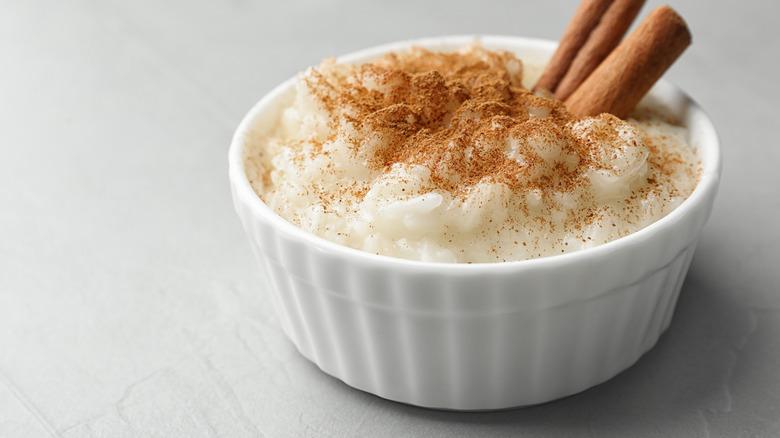
Having veered into the topic of Ayurveda, it doesn’t seem right at this point not to mention the soft food option of rice pudding. Generally speaking, the idea of using rice to thicken milk and/or eggs into a creamy, soft dessert, snack, or even breakfast dish is ubiquitous to cultures all over the world. In fact, ordering “rice pudding” in the U.S. has been known to lead to surprising results because there is no one classic American version of the dish. Rather, people tend to default to whichever version they grew up with, and that often coincides with their family’s cultural background.
German rice pudding (or milchreis), for example, tends to involve a fruit compote stir-in. Ayurvedic rice pudding, meanwhile, is meant to warm the body and stabilize the nervous system, and does so, explains MAPI, through its use of the digestive-promoting spices of cinnamon and cardamom. This version is also meant to be made with palm sugar, a sweetener known to be rich in amino acids.
The Cuban version of rice pudding arroz con leche features vanilla and cinnamon, while the Scandinavian equivalent starts by cooking the rice in a combination of milk and butter and, like the Ayurvedic version, features cinnamon and cardamom. Lastly, forbidden rice pudding, a dish commonly served for breakfast in Southeast Asia, starts with black, glutinous rice and adds in sugar and coconut milk.
Peanut Soup
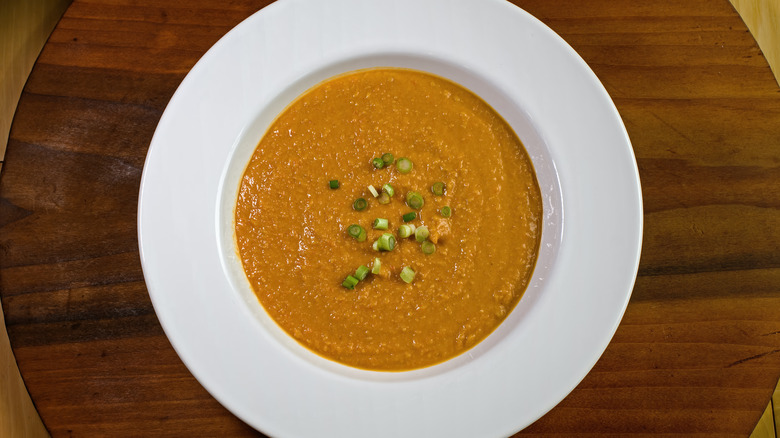
Just like eggs, peanut butter offers a significant bang for the nutritional buck. A single 2-tablespoon serving of peanut butter delivers 7 grams of protein (around the same as a single chicken egg) and is also a rich source of minerals (e.g., magnesium, phosphorus, and zinc), as well as vitamins such as niacin and vitamin B6.
However, at 190 calories for a single serving of peanut butter, it is significantly more nutritionally dense than a single serving of eggs, per the USDA. But that’s not necessarily a strike against peanut butter when it comes to soft foods because it means that each mouthful delivers relatively more energy. When the food is as nutritious as peanut butter, that can be meaningful, especially when there’s concern that a soft food diet might lead to loss of weight or muscle mass.
As much as peanut butter goes with jelly, it also works as a savory food, whether by the spoonful or as an ingredient in soups, stews, and chilis. It can easily be added to smoothly pureed soups for a nutritional punch — requiring no chewing, only swallowing. Not sure how to use peanut butter as a savory food ingredient? Start with this recipe for curried peanut squash soup and see what it inspires.
Grits and Polenta
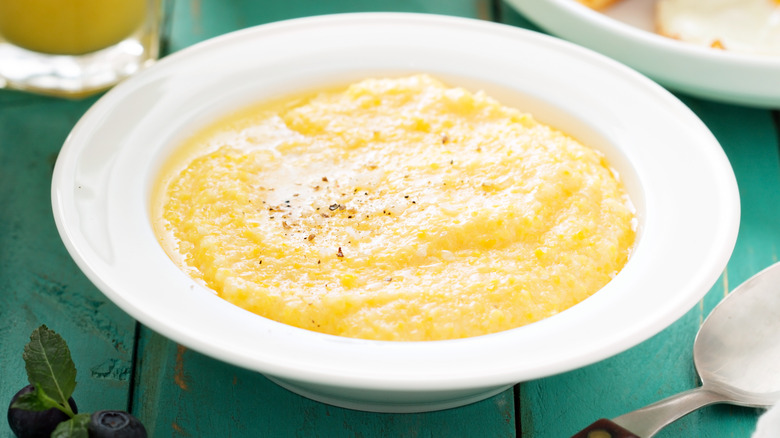
Both grits and polenta are porridges made from coarsely ground corn (as opposed to cornmeal, which is ground more finely). Both taste richly of corn flavor, making for a satisfying hot cereal at breakfast time. At the same time, both grits and polenta work really well as a blank canvas for other, more richly flavored foods — in much the same way that mashed potatoes, pasta, or rice can. The primary difference between grits and polenta is cultural. As Southern Living notes, while Italians are the polenta masters, Southerners have laid claim to grits and made them their own. So, whereas you might see polenta served with osso bucco at an Italian bistro, you’ll see grits served with creole shrimp at a Southern restaurant.
In addition, polenta is usually yellow — having been made with ground yellow corn, as opposed to the ground white corn that most grits are made from. And whereas grits are almost always served as a porridge, polenta can be served as a porridge or formed into soft cakes. Both blend well with cheese, in the same way that arborio rice does. This cheese grits recipe, for example, would work equally well if made with polenta, rather than with grits.
Dumplings
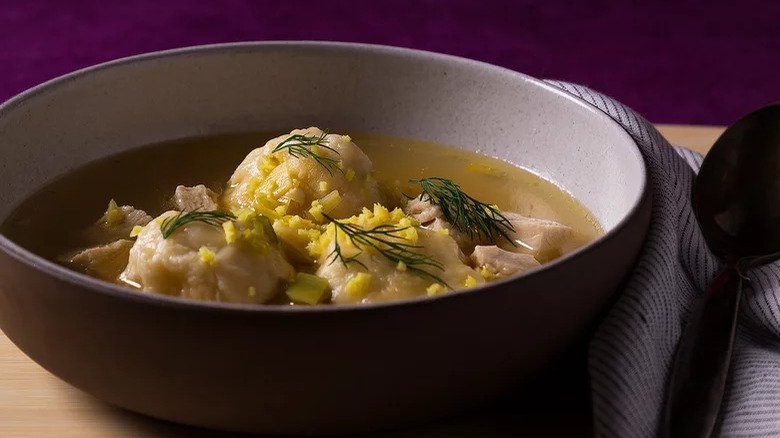
Dumplings, which are ubiquitous throughout many cultures, serve much the same purpose as grits and polenta in that they make a soft, easy-to-swallow, and satisfying side dish to accompany any number of savory, saucy dishes. However, dumplings, which are made with flour, water, and salt, tend to be softer and even easier to swallow than grits and polenta, which are made from ground corn (which is coarser than flour).
Depending on the culture, dumplings may have other ingredients as well. For example, Italian dumplings, aka gnocchi, are typically made from mashed potatoes and/or ricotta cheese, in addition to flour. German dumplings, or spaetzle, meanwhile, are smaller than gnocchi and eggier, according to Fox Valley Foodie.
Chinese har gau (or har gow) dumplings are made from a mixture of wheat flour and tapioca starch and are usually formed into thin pancakes and filled with a soft, savory mixture of meats and/or vegetables, per the School of Wok. Still other Chinese dumplings may be made with rice or rice flour, while other Asian cultures will have their own unique take and flavor, too.
The Jewish knaidel dumpling is made from matzo meal rather than flour, and is almost always served in chicken soup (via TIME). Southern cuisine has its own version of dumplings as well, which are typically served with a slow-cooked chicken stew, as they are in this chicken and dumplings recipe.
Tamales
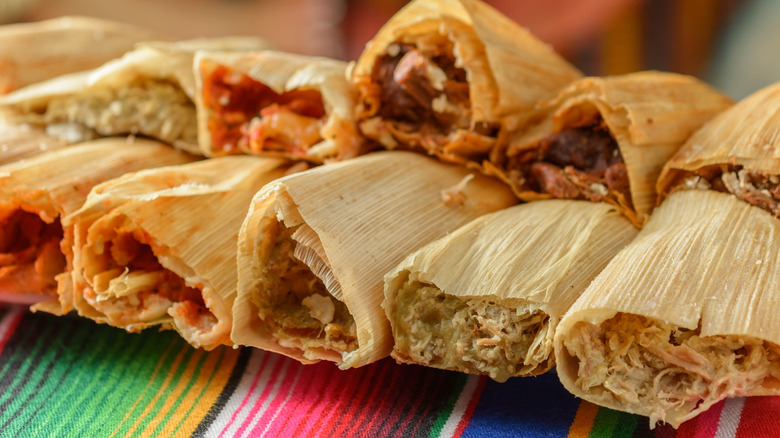
Tamales, which are essentially soft cornmeal dumplings (made with masa, a type of ground corn) filled with slow-cooked shredded meat, beans, and/or vegetables and steamed while wrapped in corn husks (“tamale” comes from the Náhuatl word for wrapped), are often thought of as being in the same general Mexican food category as tacos, enchiladas, and burritos. However, the tamale has been around for a lot longer. According to Munchery, many historians date the tamale to the Aztec civilization — some 10,000 years ago, deducing that warriors could take them into battle and hunters could easily carry them as well.
If tamales were satisfying, energy-dense, and nutritious enough to sustain ancient warriors and hunters, then just think of how well they can do as a menu choice when you’re restricted to eating only soft foods. This said, since the flavor of tamales is enhanced by the use of flavorful fats and pungent seasonings, they may not be as easy to digest as other dumpling-type foods.
Black Bean Soup
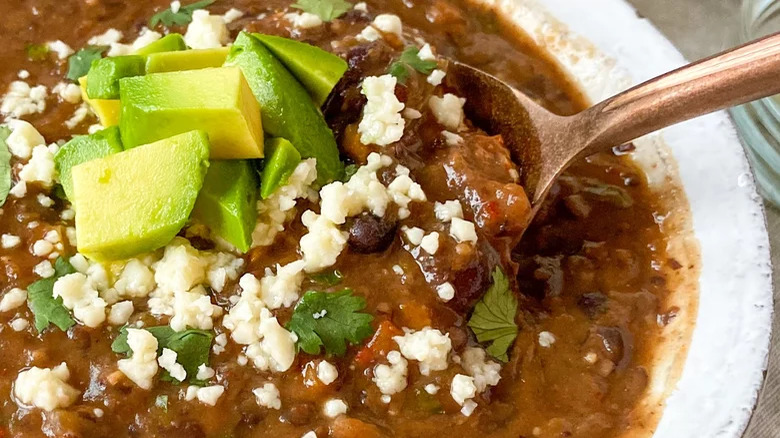
Black bean soup is another nutritionally dense soft food option. That’s because its No. 1 ingredient is black beans, which the USDA considers to be both a vegetable and a protein. And while black beans are also high in carbohydrates, eating them is not associated with the blood sugar spike that many other carbohydrates can cause. In fact, studies have shown that black beans, when eaten with rice, can help lower blood sugar levels. In other words, a bowlful of black bean soup is not likely to leave you hungry an hour later.
Black beans, themselves, are mildly sweet, but black bean soup tends to be rich and spicy, especially when started with sofrito, which is an “aromatic blend of vegetables, herbs, and spices” that is used as a foundation for many dishes in Hispanic cooking, according to Spices Inc. Like tamales, however, black bean soup is appropriate only when spices and heat can be tolerated. In addition, black bean soup is high in fiber. While that helps to make black bean soup feel particularly satisfying, it can also make it more challenging to digest than, say, grits or polenta. If your soft food diet can tolerate a bit of heat and fiber, then you should give our recipe for spicy black bean soup a try.
Osso Buco
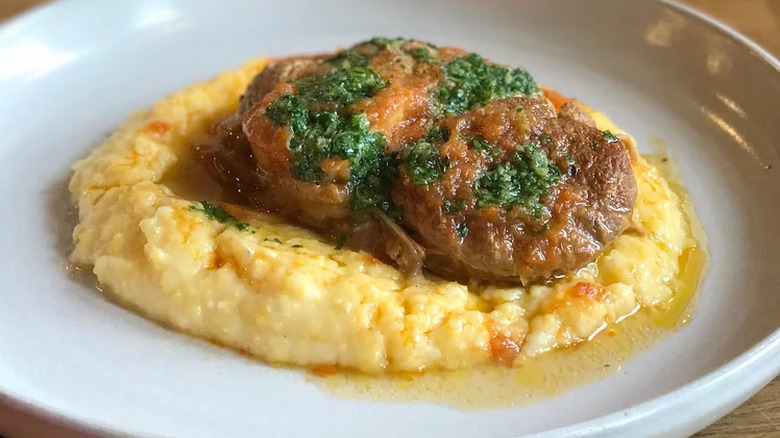
According to WebMD, soft food diets should include sources of protein, which can help the body to heal after injury or surgery. When coming up with ideas for proteins to include in a soft food diet, meats may not necessarily be the first thing to come to your mind. However, a number of meats can be appropriate when one is restricted to soft foods, just as long as they are either flaky and tender to begin with (such as virtually any cooked fish) or they are cooked at a low enough temperature and for a long enough time to render them tender. A perfect example of the latter category would be osso buco, although you might not know that by its name, which is Italian for “bone with a hole (via Greatist).
Osso buco gets that name because it consists of a cross-cut shank or shinbone of a young calf or lamb, and it always includes a marrow bone at its center. Braised in a mixture of wine, stock and earthy seasonings, osso buco isn’t ready until it’s fork tender. Then it’s served either au jus or with gravy, and often perched atop polenta. Does it look like soft food? Perhaps not? And yet it is, and a satisfying, well-seasoned one at that.
Mashed Potatoes
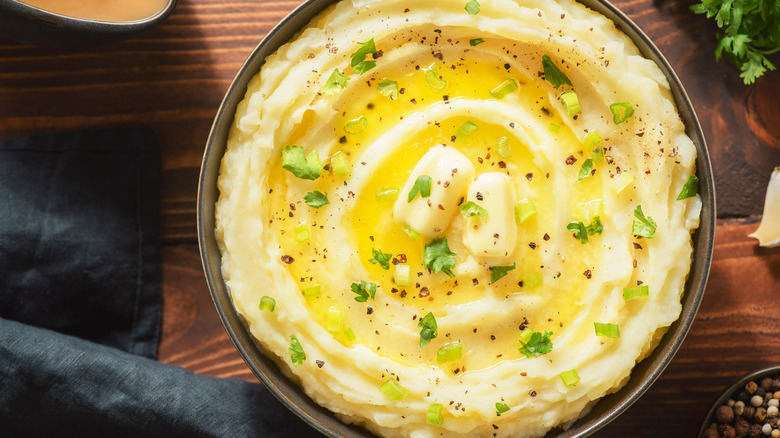
The potato easily lends itself to most soft food diets. The exception would be anything with crunchy edges such as french fries, tater tots, and the like. But we’re not here to extol the virtues of crispy fried potatoes. First, they really don’t need our help. More importantly, we’re on about soft foods at the moment, and between baked potatoes, boiled potatoes, and mashed potatoes, there’s a lot of soft food ideas to choose from. Of course, nothing can really compare to mashed potatoes when it comes to food that is both soft and comforting. When you think about it, what even are mashed potatoes except for a porridge made from potatoes, as opposed to say, ground corn, rice, or wheat?
Well, actually, mashed potatoes do contain something that some of those other porridges may not, and that is milk or cream. Unlike, say, grits, mashed potatoes require the addition of milk to the starch. And butter is kind of a prerequisite as well. Fortunately, there are many nondairy substitutes for milk and various vegan butters that can easily pinch-hit for the relevant animal proteins.
Ice Cream and Gelato
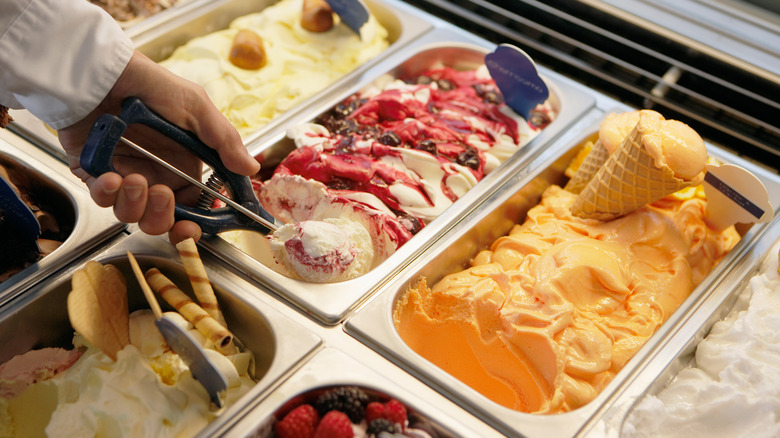
Dessert may not have a place in the “essential” food groups, but the concept of dessert may actually be essential to humanity’s survival. As food scientist Steven Witherly noted in his book “Why Humans Like Junk Food” (via Insider), eating something sweet at the end of a meal helps to re-energize the appetite. The reason is that, just as our sense of smell grows fatigued after prolonged exposure to any particular scent, so too does our sense of taste after prolonged exposure to any particular type of food (such as a main meal). When we transition to dessert, our appetite returns and “we indulge in the pleasures of eating once again,” he explained.
Almost any frozen dessert can work as a dessert or snack alternative when you’re following a soft foods diet. But why settle for a rock-hard popsicle when you can spoon up a bowlful of ice cream or gelato? Unless, of course you prefer popsicles. But for the rest of us, soft, creamy, melt-on-your tongue ice cream and gelato are essentially a no-brainer on any soft food diet that doesn’t restrict dairy or sugar. Of course, there are also a wide variety of nondairy and sugar-free ice creams and gelatos to choose from, too. By way of an example, here is a vegan salted caramel ice cream that tastes creamy and delicious — and what’s even better, you can make it at home.
Meatloaf (and ‘Meat’ Loaf)
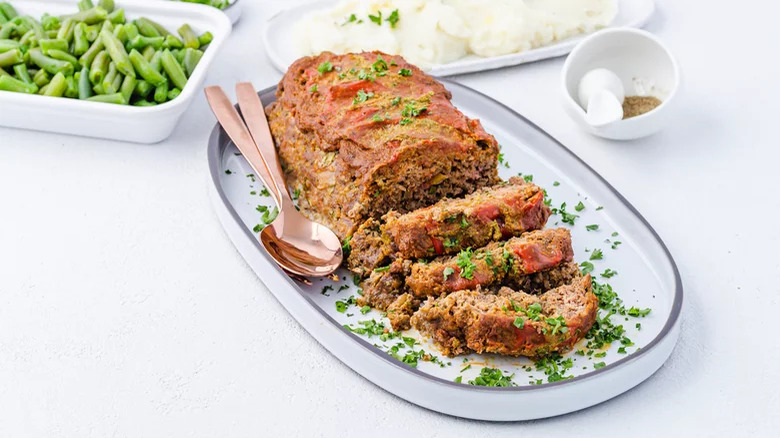
Slow-cooked meats such as Italian osso buco and American pot roast can be a highly flavorful, high-protein, calorically dense option in a wide variety of soft food diets. But not everyone has the time to spend chopping up mirepoix and braising a veal shank. Nor does everyone want to spend the kind of money it takes to purchase a veal shank. In fact, sometimes, you just gotta have the meatloaf, and luckily, if you’re restricted to soft foods for any length of time, meatloaf is a perfect option. In fact, it offers pretty much everything that an osso buco or a pot roast does, only a lot faster, a lot cheaper, and a lot more comforting to a lot more people.
Moreover, meatloaf is nothing if not flexible. It can be either more or less generous with the seasonings. It can be made with almost any ground meat or combination thereof, and it can be stretched into more servings simply by mixing in breadcrumbs, eggs, and even ground vegetables. In fact, some (vegan) recipes consist solely of vegetables. And meatloaf is a natural topper for other soft foods such as its classic dinner partner, mashed potatoes. However, meatloaf (or “meat” loaf) can be equally delicious and satisfying when perched atop a bowl of cheesy grits.
Mapo Tofu
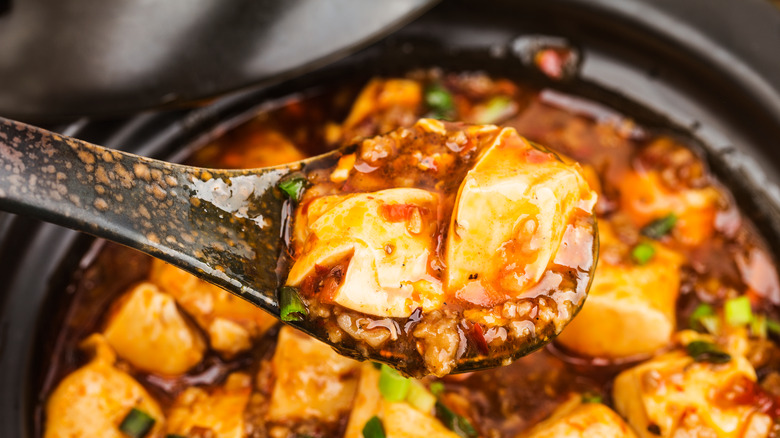
Chinese food is often associated with crispy stir-fried or deep-fried meats and vegetables, and while that’s certainly one way to go with Chinese food, it wouldn’t be the route you’d want to take when restricted, for any length of time, to eating only soft foods. In fact, a lot of Chinese food is pretty much the opposite of what you might think of as soft food. There are plenty of exceptions, however, including various soups, fried rice dishes, and soft noodle dishes. But when it comes to soft food diet-appropriate Chinese food, it doesn’t get much more tasty, filling, and nutritious than spicy bean curd, or mapo tofu.
A classic dish from the Szechuan province of China, mapo tofu is warm, filling, rich in protein, and (best of all) has a “smooth, silken consistency,” says BigOven, which makes it the perfect Chinese dish to order when you’re looking for soft (but not bland) foods.
Bananas Foster
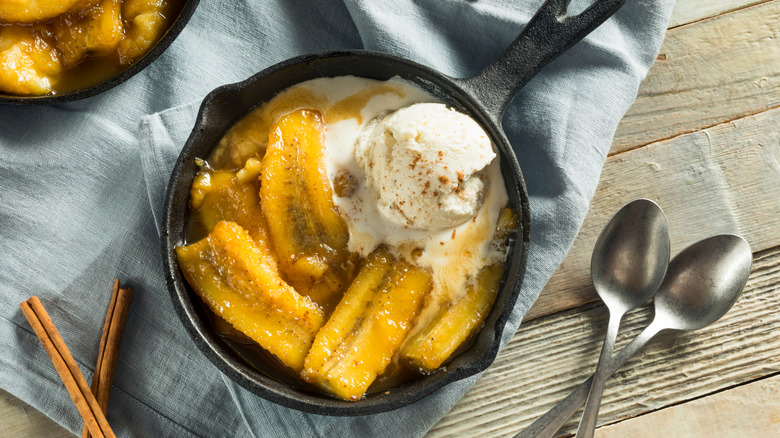
One thing that is almost never difficult to find amid the available choices on a soft food diet is a satisfying dessert. With so many wonderful puddings and custards, ice creams and gelatos, layer cakes, cheesecakes, fruit pies and the like, there really isn’t all that much to add that you probably have not thought of already. One notable exception, however, is bananas Foster.
Bananas Foster, which NewOrleansRestaurants.com and NPR trace back to 1950s New Orleans — when the Big Easy was a “major port of entry for bananas shipped from Central and South America,” got a lot of attention in its first decade or so of existence. However, today, it seems to have gone the way of rumaki (a tiki restaurant favorite) and quiche (which is still out there, just not as prominently as it was in the 1970s, per the Los Angeles Times).
But it doesn’t have to be so. And if you love the idea of ripe bananas, cooked even softer in caramel syrup and served with a scoop of vanilla ice cream, then you can have bananas Foster anytime you want, so long as you’re willing to make it yourself and have a banana or two on hand, plus some sugar and butter in your kitchen. Even better if you happen to have a few other items at the ready, including rum and a blow torch, then we’ve got the dessert recipe you need right this very minute.
Steak Tartare and Tuna Tartare
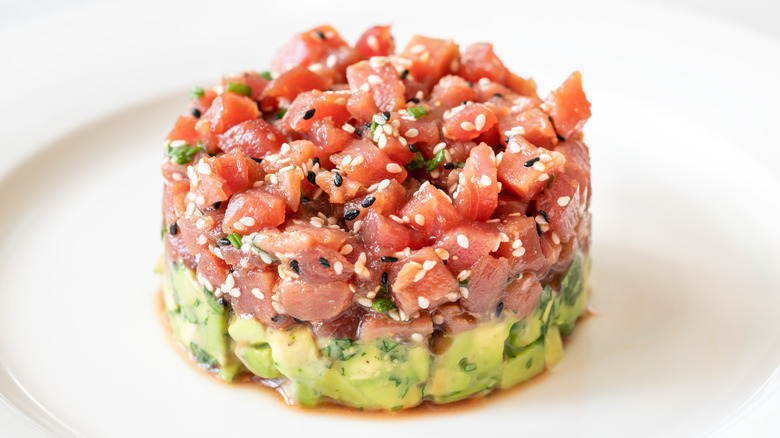
Tartare, which belongs as much to ancient Mongolia as it does to French bistros of the 1980s, per Parson’s Nose, traditionally referred to a finely chopped (sometimes even pureed) raw beef, seasoned with salt and pepper, Worcestershire sauce, mustard or tabasco, and slathered in egg yolk for a rich, smooth consistency. However, midway through the 1980s, chef Shigefumi Tachibe began experimenting at with substituting high quality raw tuna in place of the beef (via TasteAtlas). What Tachibe came up with was a combination of finely diced tuna tossed in a dressing of egg yolks, olive oil, and mustard (almost like a deconstructed aioli sauce) and accessorized with diced avocado, peppercorns, capers, chives, and tarragon.
Whether beef, tuna, salmon or something else entirely, tartare makes a perfect soft food meal or appetizer that’s high in protein and long on taste. And many people find it visually pleasing as well.
Cassoulet
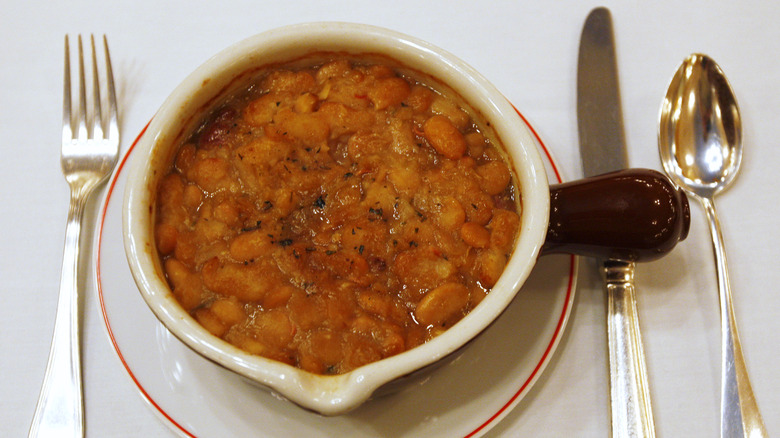
Cassoulet, a classic stew from the Languedoc province of France, has been called the ultimate in French comfort food. Originally considered a peasant food, per D’Artagnan, any given cassoulet consisted of whatever meats, beans, vegetables, and seasoning were both available and appropriate for being stewed all together in a pot, low and slow, for hours or even days at a time.
A typical modern-day cassoulet tends to include several key ingredients, including white beans cooked to be soft but not mushy, preserved duck (usually poached in oil at a temperature low enough that you’re not deep-frying the meat, but rather cooking it slowly so that the flesh breaks down and becomes meltingly tender), and sausage. However, there’s a great deal of flexibility in terms of ingredients and presentation.
If you’re planning on including cassoulet in your soft food eating plan, you’ll want to make sure that everything in it is cooked softly enough to be swallowed easily. Additionally, some of the individual pieces of meat and vegetables may need to be cut into smaller pieces before being consumed.
Gefilte Fish With Horseradish

Gefilte fish is to whitefish, pike, and carp what meatballs are to beef, pork, and veal. In other words, just as meatballs are made from ground meats, raw eggs, breadcrumbs, and various seasonings and then cooked through in a simmering sauce, gefilte fish are small savory “cakes” made from ground white fishes mixed with ground onions, carrots, raw eggs, matzo meal, and various seasonings and then poached in a flavorful, savory liquid before being refrigerated and served cold with spicy chopped horseradish.
Making gefilte fish is not really any more difficult than making meatballs, although you may not be accustomed to working with ground fish, so there may be a brief learning curve. If you’re up for it, we have a really fantastic recipe for a version that uses salmon and halibut rather than the typical white fishes. However, wonderful ready-made gefilte fish is also available in jars at the supermarket by such brands as Manischewitz and Mrs. Adlers.
Oysters on the Half Shell

Slurping raw oysters with cocktail sauce may not sound particularly urbane on paper. But in real life, it can feel surprisingly sophisticated, and more importantly, for our purposes, it requires virtually no chewing action at all, making oysters on the half shell a surprisingly elegant option for those on soft foods — as long as consuming raw foods doesn’t present a problem. If you’ve never tried oysters on the half shell, you’ll want your first time to be in a restaurant, where all of the hard work, including the tricky process of shucking, will be done before you ever see the oysters.
After that, it’s just a matter of squeezing a bit of lemon on the exposed oyster, taking your fork (usually a tiny little fork meant specifically for the eating of shellfish) and using it to move the oyster around a bit in the shell so that it comes fully loose from the shell. Then put down the fork, and using your thumb and forefinger, pick up the shell from the narrowest side, lift it to your mouth, and slurp the oyster into your mouth, and swallow. If you like cocktail sauce, which many do with their oysters, spoon a small dab onto your oyster in between putting down your fork, and pick up the oyster with your fingers.
Poire Belle Hélène

Many desserts are soft enough to enjoy comfortably while on a soft food diet, but one in particular, the classic Parisian dessert poire belle Hélène can elevate soft food eating to another level entirely. Poire belle Hélène consists of peeled ripe pears poached in a sweet, vanilla-scented syrup — one that is often spiked with a pear-flavored brandy — until meltingly soft all the way through and then served with a dark chocolate sauce and vanilla ice cream.
The poire belle Hélène gets its name from the Jacques Offenbach opera, “La Belle Hélène,” which opened in Paris in 1864, according to The Nibble. As the story goes, legendary French chef Auguste Escoffier was in attendance at that first performance, and he was so impressed that he felt inspired to come up with a recipe to honor the opera. Poire belle Hélène is often served with sliced, toasted almonds, but that’s hardly the biggest draw. Rather, it’s the tenderness of the fruit and the way the fruit’s flesh takes on the layered flavors of the poaching syrup.
Hummus

Hummus is a Middle Eastern dish consisting of mashed chickpeas (aka garbanzo beans), garlic, lemon, and tahini sauce (which is made from sesame seeds) and sometimes a swirl of extra virgin olive oil. Healthy, wholesome, and rich in protein, minerals, fiber, and vitamin B, hummus can be used as a savory dip for such crispy nibbles as fresh, raw vegetables, pretzels, and pita chips. However, if you’ve just gone through dental surgery, or, if for any other reason, you’re not in a position to chew, then you’ll need to be a bit more creative when it comes to finding ways to enjoy hummus. Or you could just keep reading because we know lots of ways to enjoy hummus that are consistent with a soft food diet.
For example, instead of dipping pita chips or baby carrots into hummus, you can try tearing off small pieces of fresh, fluffy pita bread. Or you could spread the hummus on a piece of soft white bread, and enjoy it as a sandwich, whether closed or open-faced. Additionally, you could give eating hummus with a spoon a try — especially if you already enjoy eating peanut butter straight from the jar.
27 Soft Food Ideas for Breakfast, Lunch, and Dinner

There are many soft foods, but when you need to eat them out of necessity, it can be hard to think of all the types of food available to you. Little thought is often given to the hardness of food, but sometimes soft foods are a must.
Whether you require a diet of soft foods or you have a teething baby or picky toddler, here’s a list of soft food ideas for you to try.
Soft food ideas for breakfast
Cereal, granola, and bagels can be too tough for breakfast when you need soft foods. Luckily, there are lots of breakfast foods that fit the bill.
1. Eggs

Scrambled, poached, fried, and even hard-boiled, eggs are pretty soft no matter how you cook them.
2. Pancakes
Pancakes from a box mix are easy to whip up and much softer than their frozen counterparts.
3. French toast casserole
Cut off the crusts of the bread and top with crushed strawberries for a breakfast that you can devour without much effort.
4. Biscuits and gravy
Biscuits topped with creamy gravy and bits of sausage are both satisfying and easy to eat when you need soft breakfast food.
5. Instant oatmeal
Choose your favorite oatmeal flavor or get a variety pack. Use warm milk and top with sliced bananas to make your oatmeal more filling.
Soft food ideas for lunch
For some, lunch may be the biggest meal of the day. Make it a nutritious meal by choosing several options from the list below.
1. Bone broth

Rich in minerals and good for overall health, a warm cup of bone broth with a bit of added salt and spices will ensure you’re staying hydrated even if you’re not hungry.
2. Peanut butter and jelly sandwich
Using soft bread and creamy nut butter, you can enjoy a childhood favorite.
3. Macaroni and cheese
From a box or from scratch, mac and cheese is sure to please. Cook the noodles a little longer than usual to ensure they’re soft and can be digested easily even if you can’t chew well.
4. Soup
A bit more hearty than bone broth, canned soup is great to have on hand at all times.
5. Guacamole
Make your own or buy packaged guacamole from the store. Skip the chips and eat it with a spoon or on small slices of soft cheese.
6. Potato salad

Boiled potatoes, eggs, and creamy dressing fit the bill for a soft food meal. Remember that you might need to forego (or pick out) crunchy ingredients like celery, bell pepper, and bacon.
7. Deli meat
Thinly sliced deli meats like chicken, turkey, and roast beef are rich in protein and help with recovery. Eat it on soft bread or roll it up and dip it in your favorite sauce.
8. Pasta salad
Many pasta salads fit the bill for soft foods. When buying premade deli pasta salad, make sure it doesn’t include ingredients that might hinder your recovery or upset your stomach.
9. Refried beans
Refried beans are so versatile. You can eat these warmed up with a bit of cheese or heated up in a soft tortilla. Add some sour cream and guacamole to make your own burrito bowl.
Soft food ideas for dinner
There’s no need to spend dinner eating applesauce and yogurt. All of these soft foods are great dinner options and can be made for the entire family.
1. Salmon
Baked or pan-seared, salmon flakes apart easily, so even if you can’t chew well, you can consume it.
2. Fried rice
For best results, use leftover rice plus some precooked veggie pieces. Add a couple of scrambled eggs for extra protein.
3. Canned vegetables
A quick and easy addition to your dinner, canned vegetables are great because they’re precooked and soft. Top them with things like butter, salt, pepper, and garlic powder to add some extra flavor.
4. Spaghetti and pasta sauce

Cooked well, and even on the overdone side, spaghetti and your favorite pasta sauce make an easy-to-consume yet hearty meal.
5. Tofu
There are so many ways to cook tofu that even if you’re not vegan or vegetarian, you can find something you like. It can be baked, boiled, sauteed, and even added to smoothies!
6. Mashed potatoes
You’ll get the creamiest, smoothest mashed potatoes when you make them from boxed potato flakes.
7. Baked squash
Butternut and spaghetti squash cooks up very well and can be eaten in many ways. Enjoy it plain with a bit of butter or top with a marinara sauce for a more substantial dish.
Soft food ideas for snacks
Just because you’re limited to soft foods doesn’t mean you won’t want snacks in between. And, there’s no rule for when to eat these, so enjoy them whenever you’re hungry for them!
1. Yogurt
Yogurt cups make excellent snacks. They’re just the right size and come in dozens of flavors.
2. Smoothies

Buy premade smoothies in bottles or make your own in the blender with fruit and milk.
3. Cottage cheese
High in protein, cottage cheese will take the edge off your appetite between meals.
4. Pudding cups
The quintessential food when the doctor or dentist prescribes a diet of soft foods, pudding cups are always a great option, especially when you’ve got a sweet tooth.
5. Jello cups
A bit lighter than pudding, fruity gelatin cups are favorites for people of all ages when soft foods are required.
6. Applesauce
Individual applesauce cups are handy, but larger jars are more economical.
Order soft foods online
When you need to stock up on soft food ideas to prepare for an upcoming medical procedure or need soft foods for your teething baby, one thing you don’t have time for is extra trips to the grocery store. Stock up on a variety of soft foods and save yourself time by having an Instacart shopper do the heavy lifting, literally! Choose home delivery for the most convenient, but in-store pick-up is available and ready in about two hours if you’re in a hurry. Try it now!

Instacart is the leading grocery technology company in North America, partnering with more than 1000 national, regional and local retail banners to deliver from more than 75,000 stores across more than 13,000 cities in North America. To read more Instacart posts, you can browse the company blog or search by keyword using the search bar at the top of the page.
What is a soft food diet? List of foods to avoid and the best recipes

Warning: you may have to revert to babyhood at some point.
If you have had any type of oral surgery, your dentist may prescribe a soft-food diet — in other words, food a baby would eat.
In this guide, we’ll be covering when exactly you’ll need a soft-food diet, what types of food you can and cannot eat, and how to prepare your meals.
When you should eat a soft food diet
Eating only soft foods comes in handy in many situations. In fact, this diet is good if you have had any type of mouth, tooth, head, neck, or stomach surgery. Also, you may need to follow this diet if you have a chronic issue that makes it difficult to chew and swallow.
For example, if you have gotten a dental implant placed or any type of oral surgery (wisdom teeth, braces, tooth extractions, etc.), your dentist may recommend a soft food diet. That’s a smart option because, first of all, you’ll have pain and discomfort in your mouth after the procedure. Secondly, it allows the surgical sites to heal better and quicker.
What foods to eat
Before you groan at the idea of a soft food diet, you should know there are plenty of soft foods you can eat.
Here are just a few ideas for this type of diet:
Grains
- Bread, some cereals, muffins, pancakes, or waffle
- Some cereals (soft and/or moist)
- Pasta/noodles, rice
- Saltine crackers in soup
Fruits and vegetables
- Applesauce
- Canned fruit
- Cooked/baked fruits
- Soft fruits with no skin (bananas, peaches, watermelon)
- Soft, cooked veggies
Proteins
- Eggs (poached, scrambled, or hard/soft boiled)
- Easy to chew meat, like fish, chopped/ground poultry
- Small pieces of meat in soup
- Tofu
- Baked beans
Dairy
- Cheese (thinly sliced, melted)
- Cottage or ricotta cheese
- Milk and milkshakes
- Ice cream
- Yogurt
You should eat food that have a soft texture and are nutritious while on the soft food diet.
What foods to avoid
Yes, there are also plenty of foods you shouldn’t eat. And you should be aware of what they are before you bite into anything.
Here are some off-limits foods for those on a soft food diet:
Starches
- Toast, crackers, and hard cereal
- Anything with dried fruits, nuts or other seeds
- Corn on the cob, uncooked potatoes, hard chips
- Bagels, French bread, sourdough bread
- Popcorn
Vegetables
- Corn on the cob
- Peas
- Hard, unmashed, raw vegetables
Fruits
- Hard fruits, like whole apples, raw carrots
- Stringy fruits, like pineapple and mango
- Any skin of a fruit
Proteins
- Steak
- Beef jerky
- Bacon
- Sausage
- Hot dogs
- Peanut butter (both creamy and crunchy)
You should avoid any food that’s tough, crunchy, hard, or sticky while on the soft-food diet. You should also avoid eating foods that are spicy, these can upset your stomach and cause bloating.
How to prepare soft foods
So now that you have the list of foods to eat and not to eat, how can you prepare these foods?
Below are some ideas for how to do just that:
- Cut food into small pieces.
- Use broth, gravy, or sauce to moisten food.
- Soup is a healthy and safe option in a soft food diet.
- Grind or puree foods.
- Mash foods, like potatoes, veggies, and fruits.
Recipes for the soft food diet
If you’re feeling overwhelmed with this new diet, that’s normal with anyone who begins eating only soft foods.
But don’t worry. This is not the end of the world. In fact, it’s the perfect time to try something new.
You will be able to swallow most of this food without chewing, including meat. Just shred it into tiny pieces using a good food processor.
Here’s the ultimate list of soft food recipes. These are hand-picked, absolutely the best recipes I could find online.
This page will be updated with new recipes, so make sure to pin it for your further reference.
Your teeth will love this food – guaranteed!






